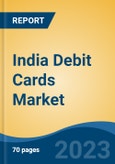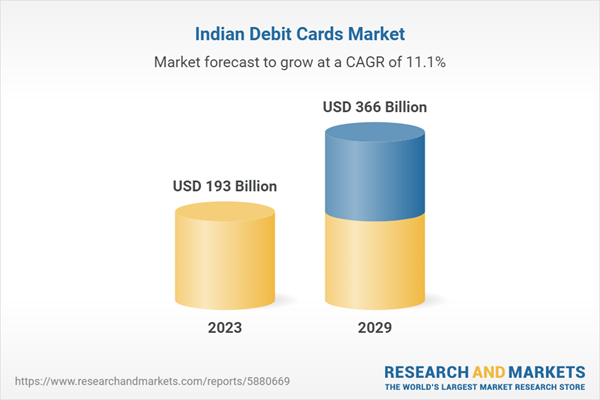Speak directly to the analyst to clarify any post sales queries you may have.
10% Free customizationThis report comes with 10% free customization, enabling you to add data that meets your specific business needs.
India Debit Cards Market Scope
A debit card is a payment card that is linked to a checking or savings account at a bank. It allows customers to make purchases or withdraw cash from an ATM, and the amount is deducted directly from account balance. Debit cards are a convenient alternative to carrying cash or writing checks, and they can be used at many merchants and retailers around the world. They usually have a personal identification number (PIN) that is used for authorized transactions and for protection against fraud.Credit cards held a 7% market share of all the cards in use, while debit cards held 93% of the market. The India debit cards market is segmented into Visa, Mastercard, RuPay, and Others (Maestro Card etc.) based on service provider. In India, Visa and Mastercard dominates the country’s debit card market. The increased value of e-commerce transactions shows the widespread transition from the physical to the digital world since the beginning of pandemic.
India Debit Cards Market Overview
The debit cards market in India is witnessing high demand owing to the changing preference in India towards technologically derived products and growing government initiatives. According to Worldline, there were 4120 million debit card transactions worth USD90 billion in 2021, 28.93 million of which were from point of sale and 21.36 million from e-commerce. Debit card transactions processed at Point of Sale (POS) terminals reached USD56 billion in value, while those processed online reached USD29 billion. In addition, the number of households with internet connections is expected to rise by 46%, from 160 million in 2021 to 233 million by 2026. Thus, with the rising smartphone and internet penetration, the India debit cards market is expected to experience a significant growth in the forecasted years.The growth of the Indian economy has led to an increase in card usage across the country. Debit cards are becoming more widely accepted as a payment option, which has further fueled the growth of the debit card market in India. The increasing adoption of digital payments in India, government initiatives to promote cashless transactions, and the growing availability of digital infrastructure and services are key drivers of growth in the market.
India Debit Cards Market Drivers
The India debit cards market has been growing steadily over the years, and there are several factors driving this growth. The Indian government has launched several initiatives to promote cashless transactions and reduce the use of physical currency. For example, the government's Digital India campaign aims to provide digital infrastructure and services to all citizens, including online payment systems. Other initiatives, such as demonetization in 2016, have also helped to encourage the use of digital payment methods. Furthermore, increase in the number of debit cards was also attributed to the issuance of RuPay cards under the Pradhan Mantri Jan-Dhan Yojana (PMJDY) scheme. More than 68 million debit cards were issued by the program's launch in 2021. Thus, these initiatives have played a significant role in driving the growth of the debit card market in India.India Debit Cards Market Trends
The banking sector is undergoing a digital transformation with new technologies and partnerships. Banks have been at the forefront of this shift in terms of payments, leading with a variety of digital innovations, but the most recent development has seen a rise in demand for co-branded credit and debit cards. Co-branded debit cards have become popular in India, with banks partnering with various companies and brands to offer debit cards with added benefits and rewards. These co-branded cards often come with cashback offers, discounts, and other rewards that make them more attractive to customers. For instance, PayPal Mastercard Debit Card is a co-branded card by Mastercard International and PayPal. It enables customers to make purchases at any Mastercard-accepting business globally using funds from their online PayPal accounts. Major companies have already adopted the trend of working with banks to offer co-branded cards to their clients for ease of payments, including airlines, hotels, e-commerce, and fuel companies. Overall, the India debit card market is witnessing several trends, including contactless payments, mobile banking, co-branded cards, e-commerce partnerships, and enhanced security features. Thus, these trends are shaping the way customers use their debit cards and are driving innovation in the Indian financial services industry.India Debit Cards Market Challenges
Debit cards are popular for online transactions, but their usage for offline transactions is still limited. This is due to factors such as the lack of acceptance of debit cards in some retail outlets and the preference for cash transactions in some parts of the country. Furthermore, with the increasing risk of fraud and cybercrime, customers are becoming more concerned about the security of their debit cards. This can lead to a lack of trust in the debit card industry and make it difficult for banks to attract and retain customers. While debit cards are a popular payment method in India, they face competition from other payment methods such as mobile wallets and UPI. For instance, In December 2022, the UPI registered more than 7.82 billion transactions costing USD160 billion, according to data released by the National Payments Corporation of India (NPCI). These payment methods offer a convenient and secure way to make payments, and their popularity could limit the growth of the debit card market in India.Market Opportunities
India is expected to add 140 million middle-class households and 21 million high-income households by 2030, which would increase demand for and drive market growth for the country's debit cards due to the availability of a wide range of services and rising consumer knowledge of digital transactional platforms. Furthermore, India offers significant opportunities for Debit Cards businesses in the underserved populations in tier-II and tier-III towns.Mobile banking has been on the rise in India, and debit cards are playing a critical role in this trend. With the increasing availability of mobile banking apps, customers can now access their debit card accounts on their smartphones, allowing them to make payments, transfer funds, and perform other banking transactions on the go. Many banks in India are partnering with e-commerce companies to offer debit cards that can be used exclusively for online purchases. These debit cards often come with discounts, cashback offers, and other benefits that are tailored to online shoppers. Thus, with the increasing adoption of digital payments in India, the debit card market presents an opportunity to tap into this trend and offer a convenient and secure payment option to customers.
Market Segmentation
The India debit cards market is segmented based on service provider, payment terminals, card type and region. Based on service provider, the market is segmented into Visa, Mastercard, RuPay, and Others (Maestro Card, etc.). Based on payment terminals the market is segmented into POS and ATMs. Based on card types the market is segmented into Signature, Platinum, Gold, and Others (Classic etc.). Based on region, the market is divided into North, South, East, West.Company Profiles
HDFC Bank Ltd., State Bank of India, Punjab National Bank, Axis Bank Limited, ICICI Bank Limited, IndusInd Bank Limited, Yes Bank Limited, Kotak Mahindra Bank Limited, IDBI Bank Limited, and Hongkong and Shanghai Banking Corporation Limited are some of the major players in the India debit cards market.Report Scope:
In this report, India Debit Cards market has been segmented into the following categories, in addition to the industry trends which have also been detailed below:India Debit Cards Market, By Service Provider:
- Visa
- Mastercard
- RuPay
- Others (Maestro Card etc.)
India Debit Cards Market, By Payment Terminals:
- POS
- ATMs
India Debit Cards Market, By Card Type:
- Signature
- Platinum
- Gold
- Others (Classic etc.)
India Debit Cards Market, By Region:
- North
- South
- East
- West
Competitive Landscape
Company Profiles: Detailed analysis of the major companies present in India Debit Cards market.Available Customizations:
With the given market data, the publisher offers customizations according to a company’s specific needs.This product will be delivered within 1-3 business days.
Table of Contents
Companies Mentioned (Partial List)
A selection of companies mentioned in this report includes, but is not limited to:
- HDFC Bank Ltd.
- State Bank of India
- Punjab National Bank
- Axis Bank Limited
- ICICI Bank Limited
- IndusInd Bank Limited
- Yes Bank Limited
- Kotak Mahindra Bank Limited
- IDBI Bank Limited
- Hongkong and Shanghai Banking Corporation Limited
Table Information
| Report Attribute | Details |
|---|---|
| No. of Pages | 70 |
| Published | September 2023 |
| Forecast Period | 2023 - 2029 |
| Estimated Market Value ( USD | $ 193 Billion |
| Forecasted Market Value ( USD | $ 366 Billion |
| Compound Annual Growth Rate | 11.1% |
| Regions Covered | India |









